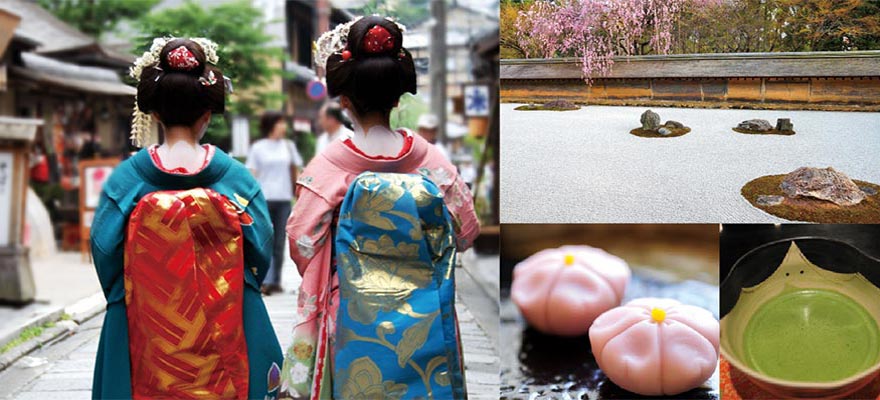Home > Highlighting JAPAN >Highlighting Japan February 2014> 47 Prefectures from A to Y
Highlighting JAPAN
47 Prefectures from A to Y
Kyoto
Behind the temples, the soft rustle of silk

Kyoto doesn't shout; she whispers. A city of elegance and refinement, a soft rustle of silk and the shushing sound of gravel being raked are to Kyoto as neon lights and skyscrapers are to Tokyo. Kyoto was Japan's historical capital for more than 1,000 years, and in addition to its more than 2,000 temples and shrines, it has a long history as a merchant hub and heartland for many traditional artisans and craftspeople.
Tucked into Kyoto's north-western corner, Ryoanji is home to the most celebrated Zen rock garden in Japan. Within these serene temple grounds stands Seigenin, a shojin ryori restaurant famous for its seven-herb simmered tofu, or nanakusa yudofu. Shojin ryori, or Buddhist vegetarian food, is known for its simplicity and seasonality, and is said to promote a long life and clear mind.
Proprietress Yuko Hasegawa consulted with the temple's head monk to open the restaurant at Seigenin 55 years ago, when the sight of the temple's many tourists led her to think they might like a place to relax and reflect. Nowadays, people come from far and wide to appreciate the restaurant's exquisite vegetarian cooking while seated on a tatami-matted dining room floor that offers a stunning view of the gardens.
Back toward the city center is the Nishijin Textile Center, the modern face of a textile association dating back to the 19th century. Here visitors can watch hand-weaving demonstrations, see a kimono fashion show and browse through brilliant piles of sumptuous garments and woven fabrics. This is a cloth lover's paradise!
Visitors can also try on a kimono themselves, choosing from a wedding costume, a maiko (a kind of junior geisha) -style ensemble, or even robes worn in the old imperial household. The dressing process may seem daunting for the uninitiated but under the expert ministrations of veteran kimono instructors, you can be trussed, wound, decorated and made up to perfection. Kazuko Ishida, resident kimono research chief, says she particularly enjoys matching the right kimono to each person. "It's not difficult, but every face is different," she says. "It's fun to see what emerges."
Of course, you can't leave Kyoto without a souvenir. Enter the world of Kyogashi, or Kyoto-style Japanese sweets, which are famously purveyed by Tsuruya Yoshinobu among others. Founded in 1803, this venerable shop creates many stunning seasonal confections, each one a work of art. "It takes more than ten years to learn the art of confectionary making," says Masahiko Mizue, an expert artisan with over 30 years under his belt.
The shop's creations are generally based on an, a sweet bean paste usually made from azuki beans or white beans. General manager Shigeo Fusho recommends trying y笛mochi, one of the shop's most popular sellers and his personal favorite. This yuzu-flavored pounded rice treat has a delicate aroma and a pleasing chewy texture that never goes out of style.
Guests who want to do more than just buy sweets can try the upstairs tea room, where they can see namagashi (fresh sweets) being made. After the demonstration, customers can enjoy their treat with a bowl of frothy matcha, smooth yet bitter green tea that forms a perfect foil to the earthy sweet flavor of the confection.
Kyoto may dazzle with her temples and shrines, but she also has secret nuances like shojin ryori, kimono-wearing and Kyogashi awaiting those who take the time to listen to her murmurs.
© 2009 Cabinet Office, Government of Japan






